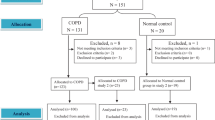Abstract
The helium to air difference in maximal expiratory flow at mid-vital capacity (ΔHe 50%) and the volume at which air and helium expired flow rates become identical (Viso \(\mathop V\limits^ \bullet \)) are currently measured from maximal expiratory flow-volume (MEFV) curves with the largest forced vital capacities (FVC) superimposed at residual volume (RV). True FVC and maximal flows may be obtained by superimposing several MEFV tracings to construct a “composite” (envelope) curve. From both theoretical and practical points of view, total lung capacity (TLC) is a more logical and more reproducible reference for matching air and helium-oxygen MEFV curves. The use of composite MEFV matched at TLC was compared to the conventional procedure in 41 healthy subjects aged 18 to 54 years. No significant difference for δHe 50% and Viso \(\mathop V\limits^ \bullet \) resulted from the application of the modifications proposed but the number of subjects with absent Viso \(\mathop V\limits^ \bullet \) increased with superimposition at TLC. The intersubject variability of the ΔHe 50% was decreased and that of Viso \(\mathop V\limits^ \bullet \) was increased. The sensitivity of both variables to the relationship between air and He + O2 FVC is stressed.
Similar content being viewed by others
References
Benatar SR, Clark TJH, Cochrane GM (1975) Clinical relevance of the flow rate response to low density gas breathing in asthmatics. Am Rev Respir Dis 111:126–134
Brooks SM, Zipp T, Barber M, Carson A (1978) Measurements of maximal expiratory flow rates in cigarette smokers and nonsmokers using gases of high and low densities. Am Rev Respir Dis 118:75–81
Clement J, Van de Woestijne KP (1971) Variability of maximum expiratory flow-volume curves and effort independency. J Appl Physiol 31:55–62
Despas PJ, Leroux M, Macklem PT (1972) Site of airway obstruction in asthma as determined by measuring maximal expiratory flow breathing air and a helium oxygen mixture. J Clin Invest 51:3235–3243
Dosman JA, Bode F, Urbanetti J, Martin R, Macklem PT (1975) The use of a helium-oxygen mixture during maximum expiratory flow to demonstrate obstruction in small airways in smokers. Am Rev Respir Dis 55:1090–1099
Field GB, Owen P (1979) Respiratory function in an Australian cotton mill. Bull Eur Physiopathol Respir 15:455–468
Fox WW, Bureau MA, Taussig LA, Martin RR, Beaudry PH (1974) Helium flow-volume curves in the detection of early small airway disease. Pediatrics 54:293–299
Hutcheon M, Griffin P, Levison H, Zamel N (1974) Volume of isoflow. A new test in the detection of mild abnormalities of lung mechanics. Am Rev Respir Dis 110:458–465
Hutcheon M, Rodarte Jr, Hyatt RE (1977) Effect of breathing helium oxygen on static lung volumes and lung recoil in normal man. J Appl Physiol 42:899–902
Hyatt RE, Black LF (1973) The flow-volume curve. A current perspective. Am Rev Respir Dis 107:191–199
Hyatt RE, Rodarte Jr, Mead J, Wilson TA (1979) Changes in lung mechanics. Flow volume relations. In: Macklem PT, Permutt S (eds) The lung in the transition between health and disease, Ch. 5. Lung biology in health and disease, vol 12. Marcel Dekker Inc., New York Basel, pp 73–112
Ingram RH Jr, Schilder DP (1966) Effect of thoracic gas compression on the flow-volume curve of the forced vital capacity. Am Rev Respir Dis 94:56–63
Leith DE, Mead J (1967) Mechanisms determining residual volume of the lungs in normal subjects. J Appl Physiol 23:221–228
Loveland M, Corbin R, Ducic S, Martin RR (1978) Evaluation of the analysis and variability of the helium response. Bull Eur Physiopathol Respir 14:551–560
Nielsen TM, Pedersen OF (1976) A method to correct for the influence of gas density on maximal expiratory flow rate. Acta Physiol Scand 98:123–130
O’Cain EF, Hensley MJ, McFadden ER Jr, Ingram RH Jr (1979) Pattern and mechanism of airway response to hypocapnia in normal subject. J Appl Physiol 47:8–12
Peslin R, Bohadana A, Hannhart B, Jardin P (1979) Comparison of various methods for reading maximal expiratory flow-volume curves. Am Rev Respir Dis 119:271–277
Rodarte RJ, Hyatt RE, Rehder K, Marsh HM (1977) New tests for the detection of obstructive pulmonary disease. Chest 72:762–768
Schilder DP, Roberts A, Fry DL (1963) Effect of gas density and viscosity on the maximal expiratory flow-volume relationship. J Clin Invest 42:1705–1713
Soto RJ, Forster HV, Rasmussen B (1975) Computerized method for analysing maximum and partial expiratory flow-volume curves. J Appl Physiol 39:315–317
Webster PM, Zamel N, Bryan AC, Kruger K (1977) Volume dependence of instantaneous time constants derived from the maximal expiratory flow-volume curve. Am Rev Respir Dis 115:805–810
Wellman JJ, McFadden ER Jr, Ingram RH Jr (1976) Density dependence of maximal expiratory flow rates before and after bronchodilators in patients with obstructive airways disease. Clin Sci Mol Med 51:133–139
Whitaker CJ, Chinn DJ, Lee WR (1978) The statistical reliability of indices derived from the closing volume and flow volume traces. Bull Eur Physiopathol Respir 14:237–247 (1978)
Author information
Authors and Affiliations
Rights and permissions
About this article
Cite this article
Teculescu, D.B., Pino, J. & Peslin, R. Composite flow-volume curves matched at total lung capacity in the study of density dependence of maximal expiratory flows. Lung 159, 127–136 (1981). https://doi.org/10.1007/BF02713908
Accepted:
Issue Date:
DOI: https://doi.org/10.1007/BF02713908




